Teespring (Spring) vs. Spreadshirt (+ dealbreakers) – decide in 7 minutes

Do you think you can monetize your audience by selling custom merch?
Not so fast.
While it can be a great way to earn good money, it will only work in case you are careful with choosing the right print-on-demand platform among solutions like Teespring (now Spring) and Spreadshirt.
And we’re here to help you with that.
While both platforms have some obvious similarities, we’re not going to waste your time by comparing all of their features one by one. Instead, we’ll highlight only the key differences and main dealbreakers that will help you choose the perfect solution for you.
Read on and let’s decide together.
Quick breakdown: Teespring (Spring) vs. Spreadshirt
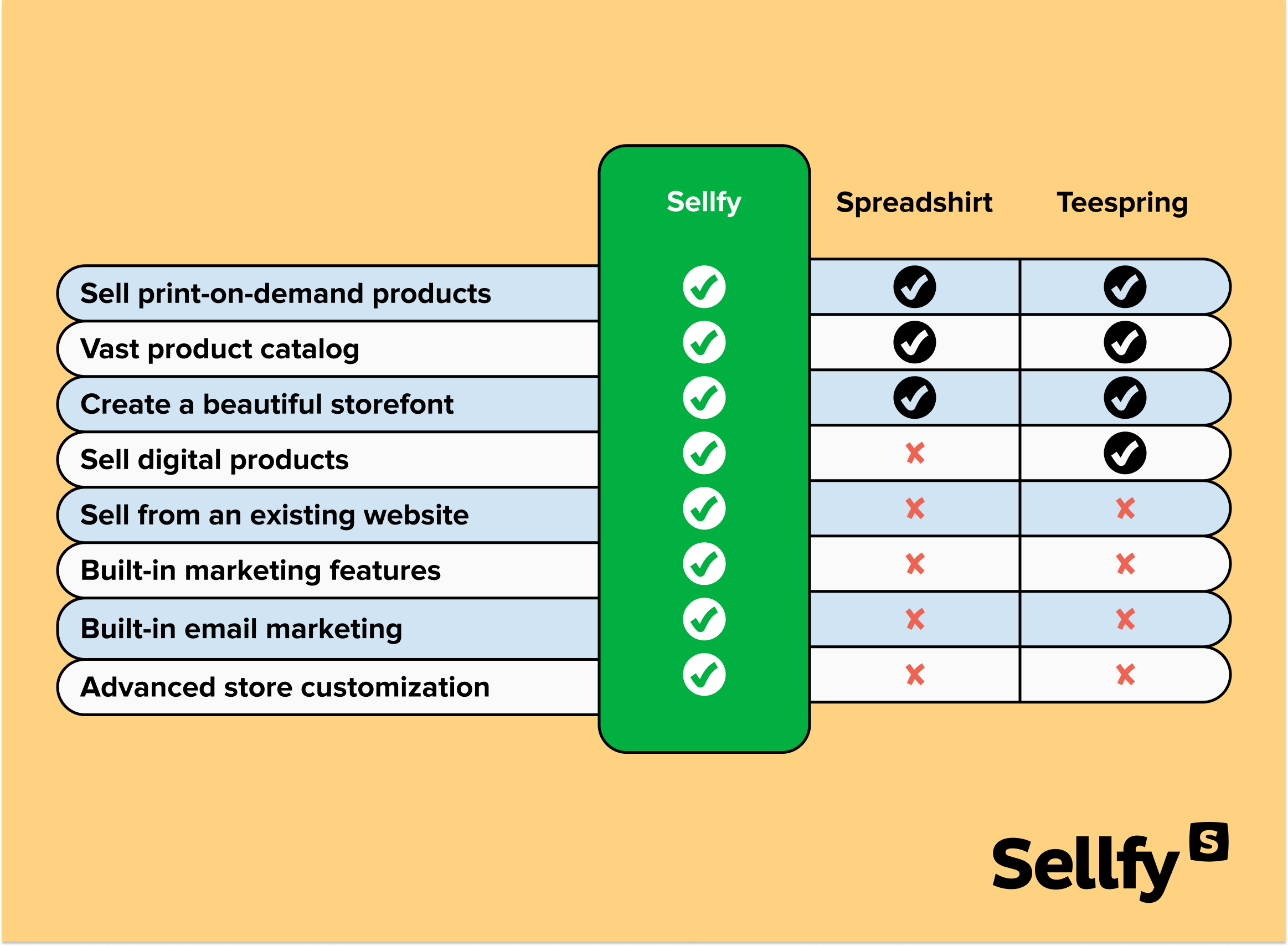
Print-on-demand companies have truly revolutionized custom merch production. Thanks to print on demand, you no longer need to worry about keeping inventory, printing, or shipping — all you have to do is design your products and… well… sell them.
While both Spreadshirt and Teespring are print-on-demand platforms, there are still some critical differences between them.
For example, Teesprind allows you to sell more than print-on-demand merch — it also can serve as a comprehensive eCommerce platform suitable for selling digital downloads.
Spreadshirt, on the other hand, offers more ways to sell custom products. You can either create your own merch store with Spreadshop or list your items on a Spreadshirt marketplace. Moreover, Spreadshirt has more expansive printing options than Teespring, including prints on several areas of the t-shirt, customizable stitches, and a more comprehensive range of fabric colors.
Both platforms were built with digital creators in mind. However, Teespring went even further, allowing creators to directly integrate with the most popular social media platforms including TikTok, YouTube, and even Twitch.
Going on, we’ll take a closer look at Teespring and Spreadshirt, evaluating only the key features and potential dealbreakers that could affect your final decision. We’re also going to include a third print-on-demand platform for comparison — Sellfy. Just so you can clearly see how Teespring and Spreadshirt not only compare to each other, but to other options in the market.
Teespring (Spring) and Spreadshirt are similar (in a way)
All differences apart, Teespring and Spreadshirt are two print-on-demand companies that specialize in custom-designed apparel. So, ultimately they both work in the same way.
Sure, there are a few noticeable differences like their product selection (or quality), shipping costs, marketplace, and eCommerce functionality.
However, the setup process is pretty similar for both solutions. All you need to do is put your custom design on products from their catalog, build a basic checkout page, sell them to your audience, and wait while they take care of order fulfillment. Plus, both platforms are free to use (sort of).
But don’t get me wrong — there are some things worth keeping in mind before committing to one platform versus another.
Why would you choose Spreadshirt over Teespring (Spring)?
Here we’ve outlined some of the advantages that make Spreadshirt stand out over Teespring.
1. You have the freedom to choose how your products are sold
Spreadshirt gives you two options: you can either sell on the Spreadshirt marketplace or create a Spreadshop store on Spreadshirt’s sister site.
Spreadshop allows you to build a personal checkout page for your print-on-demand products with just a few clicks. Plus, unlike Spreadshirt’s marketplace, Spreadshop allows you to set your price margin, apply discounts and slightly customize your storefront to match your brand.

2. You can make Spreadshirt a part of an existing online store
While Teespring is well known for integrating with various social media platforms, Spreadshirt was built to integrate with different e-commerce stores.
So if you’re looking for even more flexibility, you can simply embed Spreadshirt service into other eCommerce platforms and sell t-shirts on your own online store. This way, people won’t know that you are using Spreadshirt as your print-on-demand supplier.
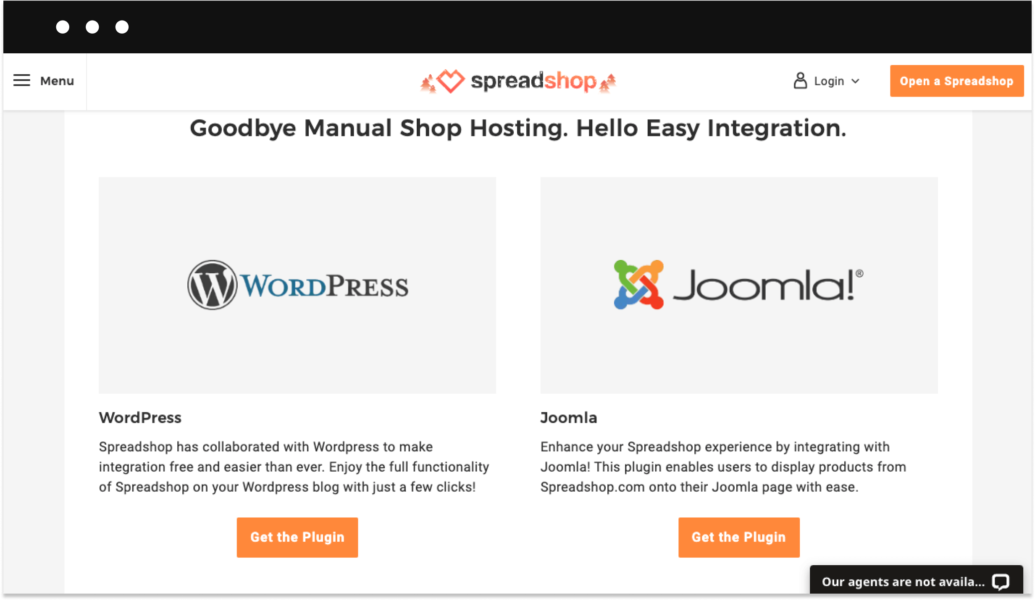
However, don’t forget that this route may bring additional costs too.
3. Spreadshirt won’t be a financial burden
You’ll be happy to know that neither Spreadshirt nor Spreadshop charges platform fees.
Plus, the good news is that there are no hidden costs, transaction fees, or commissions associated with selling your print-on-demand products.
You won’t have to pay unless you decide to use one of the ready-made designs available in the Create Tool. While there’s a pretty good selection, most of them come at extra costs that you’ll have to pay directly to the designer.
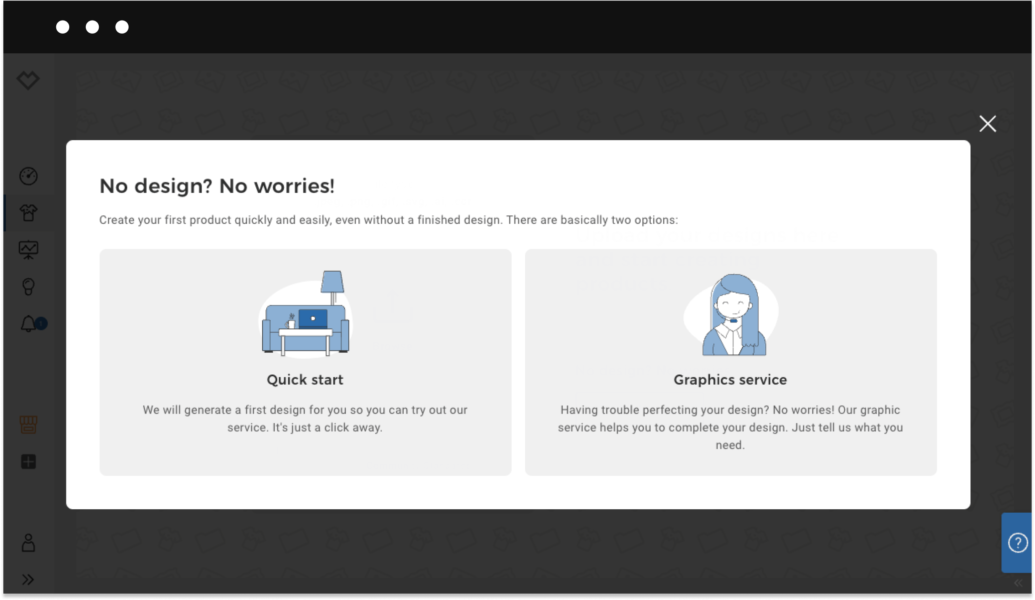
4. You can set up a merch store in mere minutes
The best thing about print-on-demand companies is that they offer you a simple way to start selling personalized products.
And Spreadshirt isn’t the exception from the rule. While the Spreadshirt’s interface is a bit more cluttered than Teespring’s, its design tool is fairly easy to figure out.
And for those who aren’t looking to sell on the marketplace, Spreadshop provides a simple-to-build online merch store. However, you must understand that there are functional restrictions that come with such simplicity.
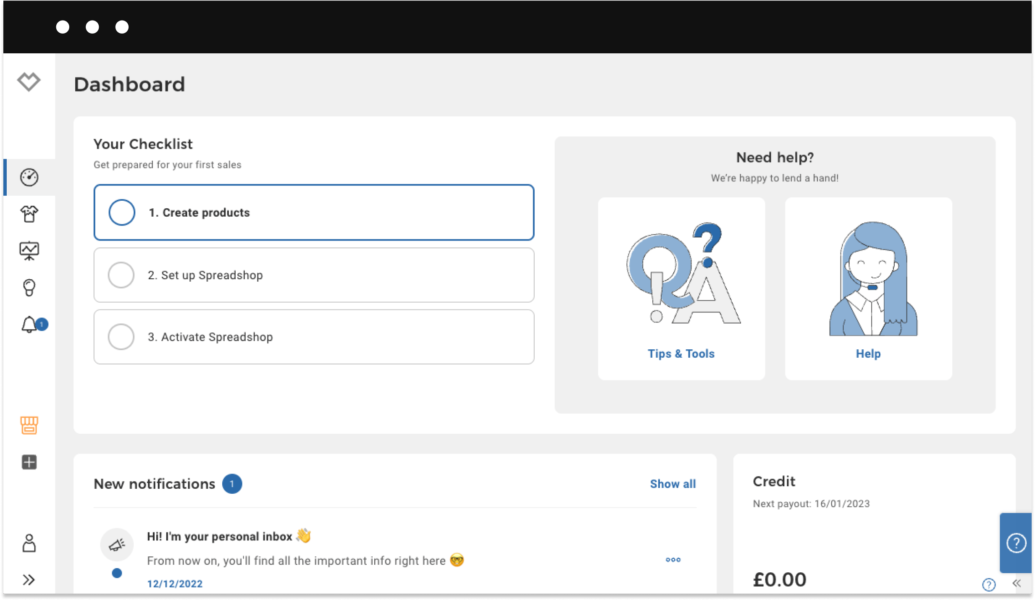
The main disadvantages of Spreadshirt
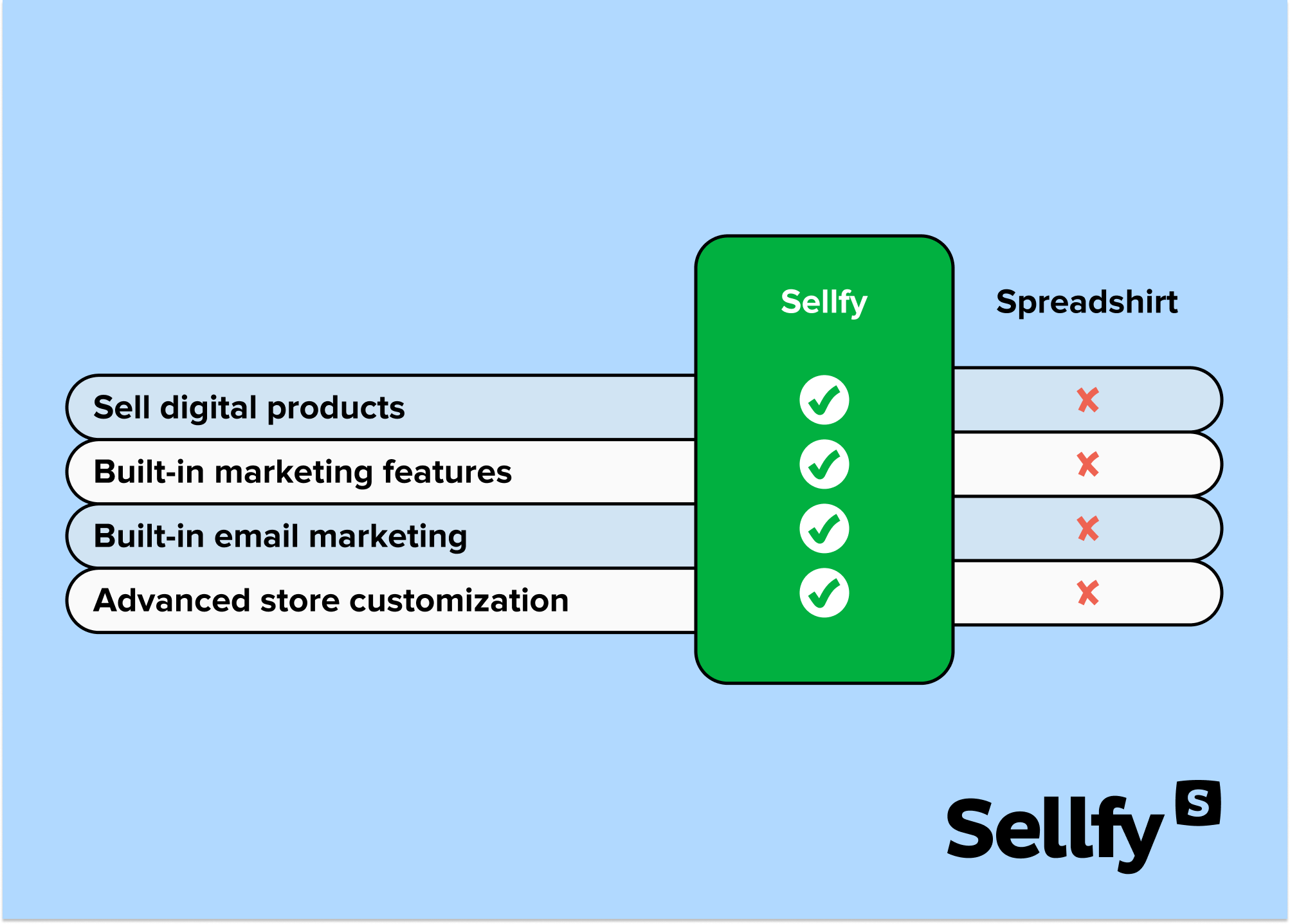
Before you take the plunge and launch your Spreadshop store, there are some crucial things that could make or break your print-on-demand business.
1. The product catalog is limited to just POD products
There’s one major difference between Spreadshirt and Teespring:
With Spreadshirt, you can’t sell anything but custom merchandise.
Of course, it’s not that huge of a problem if all you’re looking for is selling a couple of t-shirts. However, the lack of ability to offer digital products can be an enormous obstacle for more ambitious creators looking to take their business further.

2. You won’t be able to express your personality with the store design
While it’s obvious that you won’t be able to add any personality to Spreadshirt’s marketplace listing, Spreadshop’s customization possibilities aren’t that great either.
To be honest, you can hardly customize anything at all. The list of customizable elements is limited to store name, logo, and store colors.
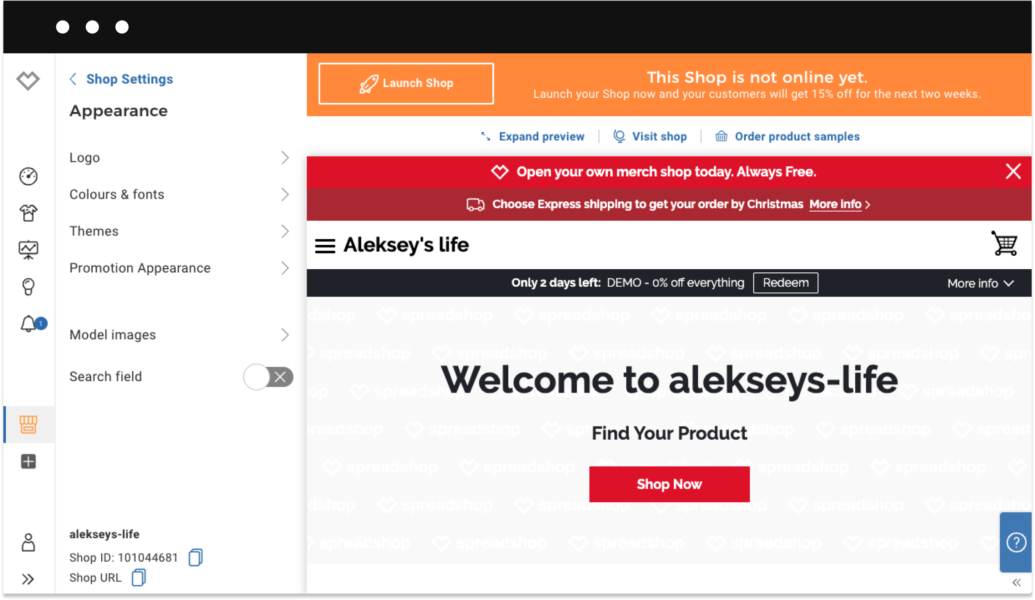
3. You’ll be stuck with no built-in marketing features
Robust promotional tools and steadily growing sales are equally essential when it comes to reaching the full potential of your eCommerce business.
Sadly, Spreadshop falls short when it comes to built-in marketing features and executing your promotional strategy.
The only built-in tool that Spreadshop offers is coupon codes for discounting your custom merch. Moreover, Spreadshop doesn’t support third-party app integrations, which makes it technically impossible to use features like upselling, cart abandonment, etc.
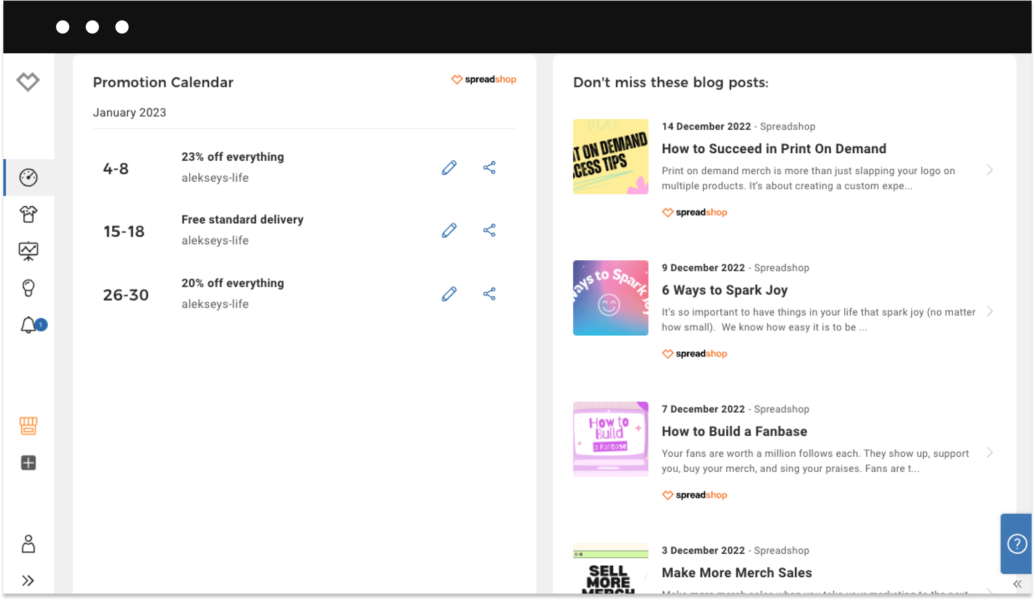
4. You have to wait for monthly payouts
Spreadshirt processes payouts to all sellers only on a monthly basis. It means that you won’t be able to access your monthly earnings before the fifteenth working day of the next month.
Moreover, if you’re located in the USA, there is an option for you to get your money transferred to a bank account. But, if you live elsewhere, you can only receive your payments via PayPal. Simply speaking, if there’s no PayPal, there’s no Spreadshirt.
Why would you choose Teespring (Spring) over Spreadshirt?
Sure, Teespring isn’t the top option when it comes to printing custom apparel, but should still be given a fair look.
Here’s why:
1. Tap into new opportunities with more than just POD products
With Teespring, digital creators can find more ways to expand their businesses beyond print-on-demand merchandise. Unlike Spreadshirt, which is a relatively basic print-on-demand marketplace, Teespring offers creators the added advantage of selling digital products.
In other words, Teespring appears to be a slightly more holistic eCommerce platform suitable for independent artists.
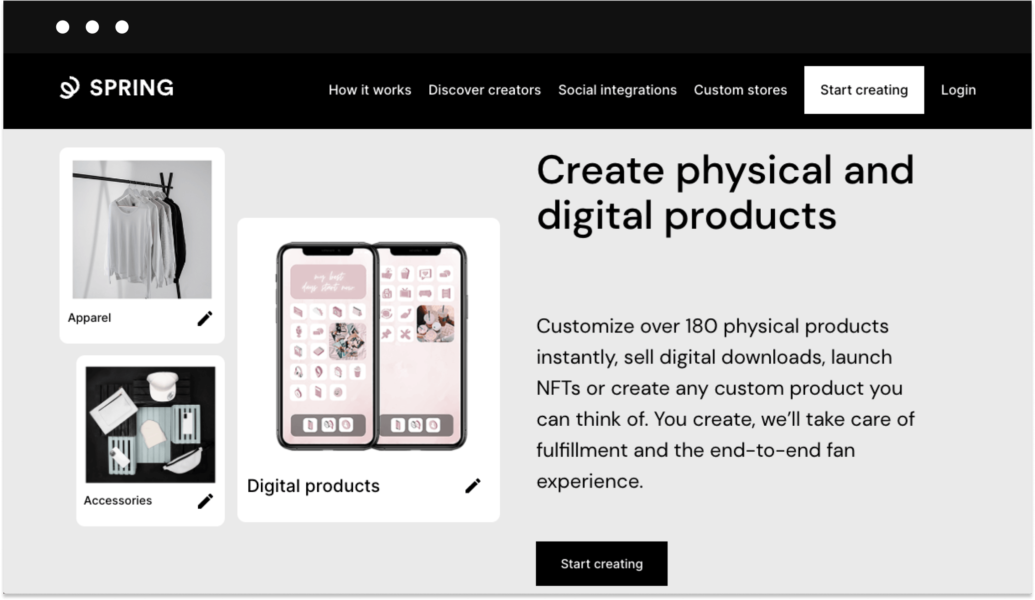
2. You can build a store for your merch free of charge
If you’re an artist or creator on a budget, Teespring may be the way to go. The possibility to sell print-on-demand and digital products under one roof is an enormous advantage over Spreadshirt.
So if you’re looking to make your mark without breaking the bank, Teespring could be just what you need!
3. Built to blend into the most popular social media channels
If you’re a digital creator with an audience, Teespring is the perfect platform for tapping into that potential. The platform offers an impressive list of exclusive integrations including a YouTube merch shelf, Teespring boosted network, Twitch merch store, Streamlabs, Discord, Instagram Checkout, and Google Shopping.
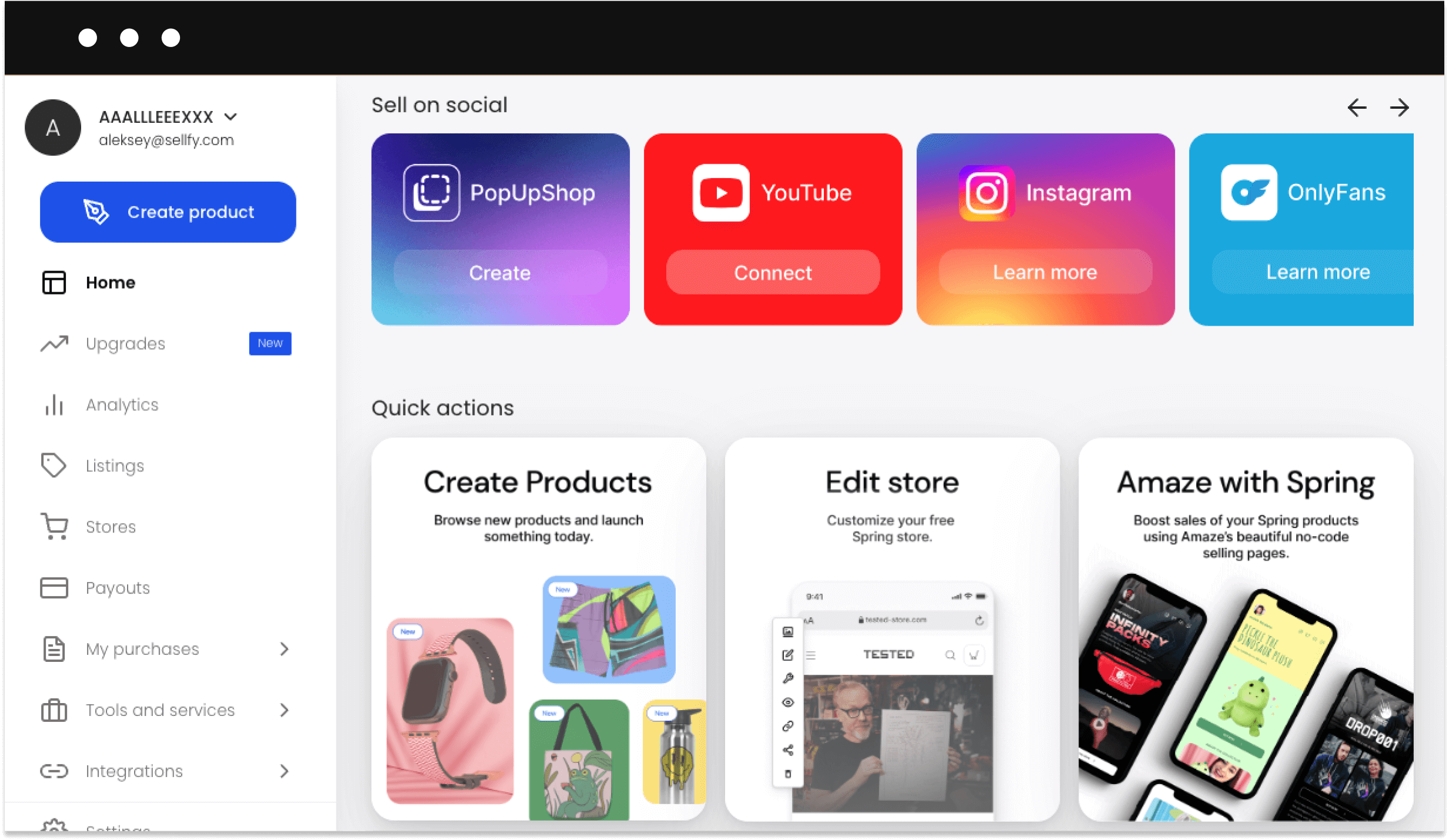
So in case you’re looking to create a new revenue stream with your existing audience on a YouTube channel, then Teespring is, without a doubt, a much better alternative than Spreadshirt.
The main disadvantages of Teespring
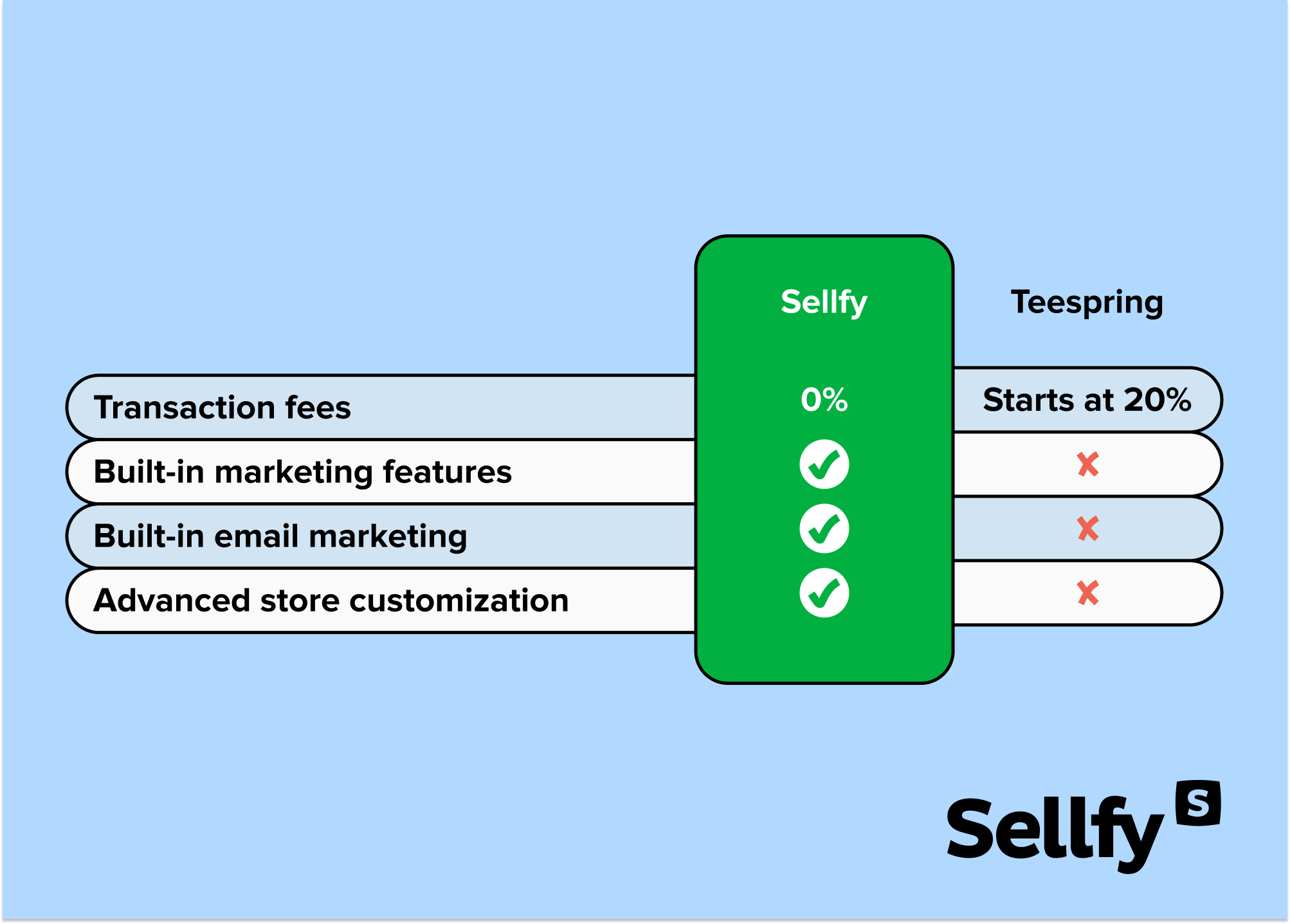
Although Teespring is clearly a viable alternative to Spreadshirt, it lacks some features necessary to become a truly top-tier print-on-demand platform.
1. Teespring’s hefty transaction fee is the talk of the town
Without exaggeration, Teespring’s transaction fee for digital products may come as bit of a shock — Teespring sellers have to share 20% of your profit. It means that in case you’re selling a $100 product, they will still keep $20 from each sale. If you make five sales a month, your monthly fee will sum up to $100.
Plus, you’ll have to manually request payouts after settling with their steep charges.
So the big question is:
Can we really consider Teespring to be a free-to-use platform after all?
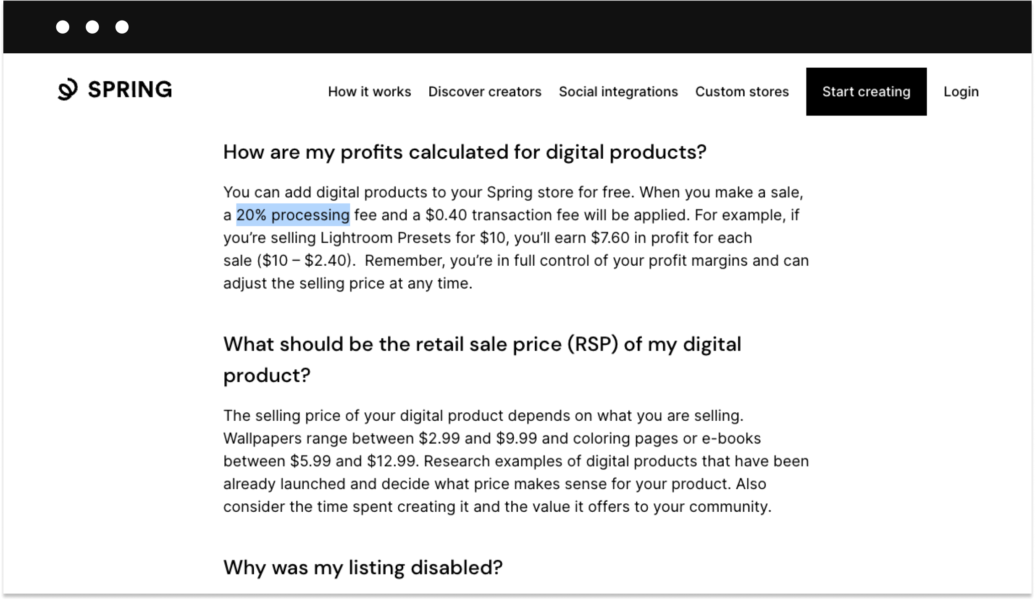
2. There are not enough promotional tools to help you grow your business
Sure, Teespring undoubtedly offers more built-in eCommerce features when compared to Spreadshirt and Spreadshop.
For example, it lets you create and sell custom merch, digital downloads, and even NFTs! Plus, its handy integration with social media helps reach more potential customers.
However, unlike all-in-one solutions like Sellfy, Teespring doesn’t offer other promotional tools. So you won’t be able to make bump offers, upsell or cross-sell products, or send cart abandonment emails.
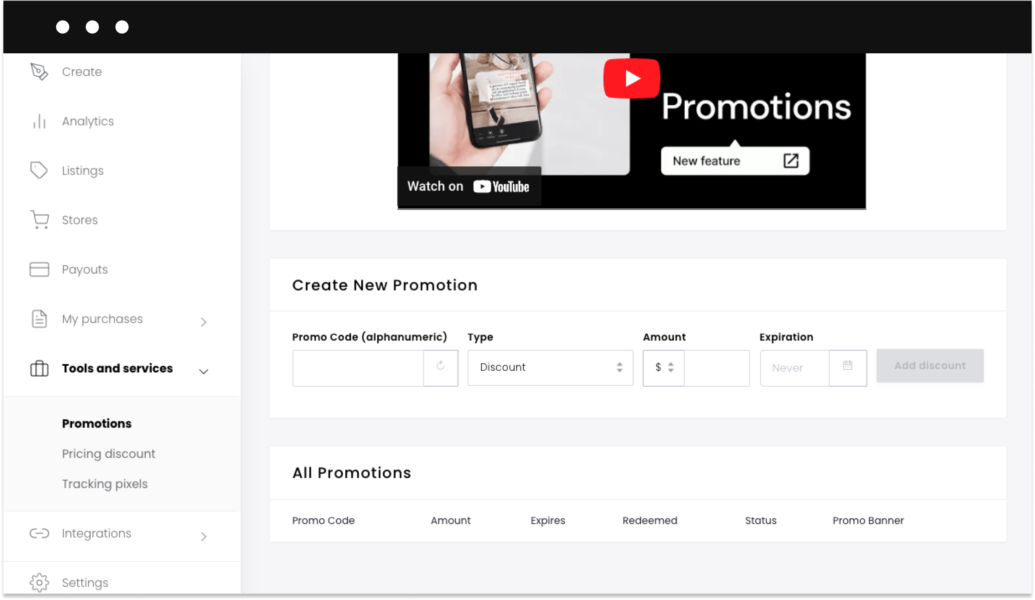
3. There’s a three-day minimum printing cycle
This means that your custom products won’t really be produced on demand. Instead, Teespring will collect all orders placed every three days, and only then print and ship them to your customers.
4. Teespring (Spring) hasn’t always left customers with the best expression
There have been several occasions when Teespring was accused of oversight when it comes to allowing inappropriate apparel that promotes violence and includes racist messaging.
Additionally, customers have expressed dismay over the quality issues encompassing both product durability and print quality.
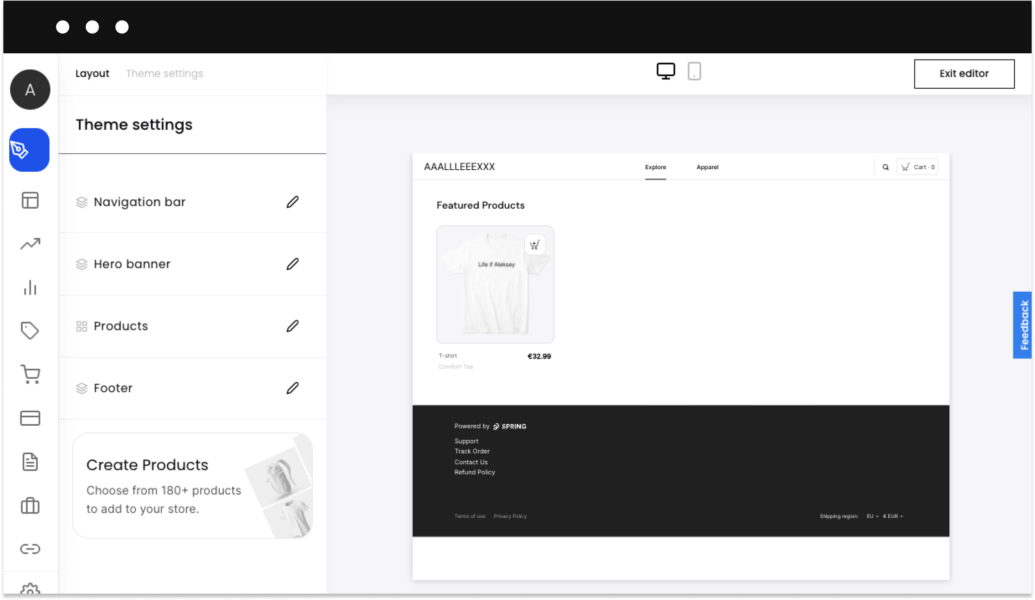
The question isn’t Spreadshirt vs. Teespring (Spring) — it’s why not Sellfy?
It’s time to make a final decision between Teespring and Spreadshirt.
To sum up:
Spreadshirt is known for its robust marketplace and the possibility to integrate print-on-demand products into an existing online store. On the other hand, Teespring offers a more advanced eCommerce toolkit.
But before you make your final decision, here’s something worth considering:
There’s another alternative to both Teespring and Spreadshirt that not only offers a toolkit that may surprise you but also a perfect balance between usability and customizability.
Without further ado, let me introduce you to Sellfy.
So much more than just a print-on-demand service
Built for creators and digital entrepreneurs, Sellfy is an all-encompassing eCommerce solution that is an excellent alternative to platforms like Teespring and Spreadshirt. The best part is that apart from selling digital and physical goods, Sellfy has a built-in print-on-demand service.
Thanks to the streamlined setup process and smooth user interface, you can launch a professional online store for both digital and physical goods in 10 minutes flat. Plus, you’ll get access to built-in marketing tools, excellent customer support, and the possibility to embed the “buy now” button on your existing website.
You get the ultimate tools and resources to promote your products
We’ve already shown you that both Bonfire and Teespring offer a bare minimum of built-in features. Especially when it comes to marketing tools.
Sellfy, on the other hand, has everything you need to reach your business goals quickly and effectively, including email marketing, discounts & coupon codes, upselling, cart abandonment, pay-what-you-want pricing, and third-party integrations.

No hidden fees on all plans
When it comes to selling print-on-demand products, Sellfy doesn’t just stand out with its comprehensive product catalog and customization features but also with a transparent pricing policy.
With Sellfy, you can forget about outrageous transaction fees.
Perfect for selling print-on-demand merchandise
With Sellfy, you don’t need to worry about minimum order requirements or printing cycles — whatever you sell will be put into production right away.
Simply choose the perfect print product, upload your design, and set an affordable price. The best part is that you can fill up your own store with as many products as you need — no need to worry about unsold merch or stocking inventory!
Your product price will consist of two components: product base price + your added pricing. The difference between your prices and the base price is your profit margin.
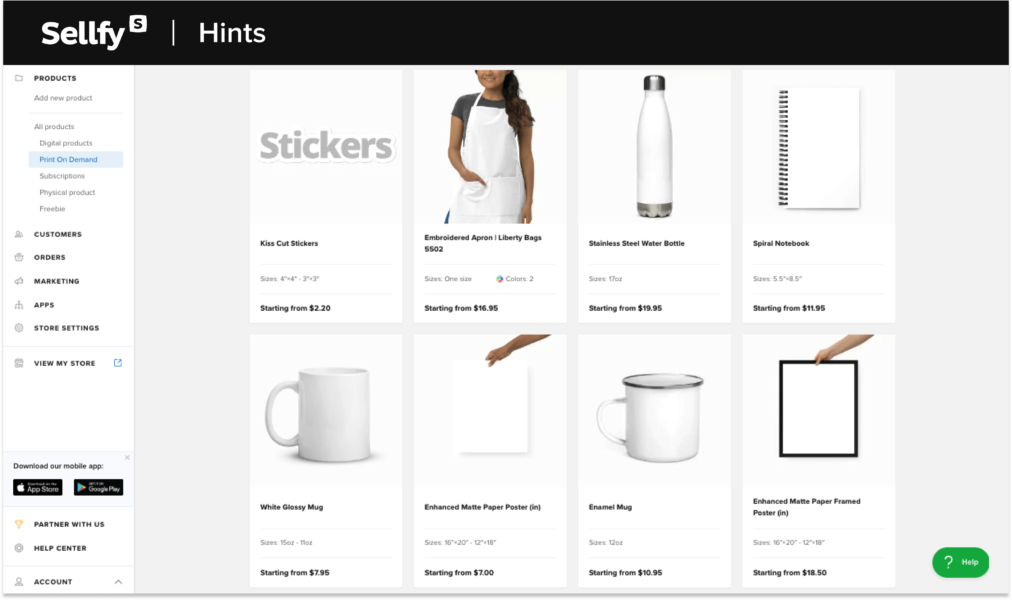
Stellar customer support
Starting something new is always difficult, but with Sellfy’s customer support, you won’t have to do it alone. They are at your service day and night, ready to help you to tackle any issue you may encounter.
There are also extra seller support services, like knowledgebase articles to help you with things like calculating shipping costs, and more.




